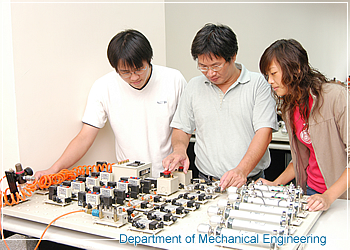Fax:886-5-226-3723
E-Mail:yhkao@wfu.edu.tw
Cht:http://me.wfu.edu.tw/
Eng:http:// www2.wfu.edu.tw/wp/english/?p=71
The educational objectives of Mechanical and Intelligent Manufacturing Engineering Department are designed to provide background for a wide variety of careers. The discipline and the curriculum combine theories and techniques to foster well-trained mechanical engineer who is able to do his/her good job in various production manufacturing industries after his/her graduation. The graduates can also join government laboratories or research agencies to deal with technical problems, and they can pursue further study in graduate school. The academic programs cover a wide range of subjects, including machine design and manufacturing, electro-mechanical system, automation and digital control, reverse engineering and rapid prototyping, software analysis and design of CAD/CAM, PRO-E, and Cartia, the development of semi-conductor process and optical component, as well as the knowledge of Nano-technology.
The curriculum of Mechanical and Intelligent Manufacturing Engineering Department is intended to
- Familiarize students with basic knowledge and engineering applications.
- Enhance the professional skills in the field of electro-mechanical system and automation engineering, and master the engineering analysis and machine design software.
- Help students to pass a variety of skill proficiency tests and obtain professional certificates approved by the governing agencies.
There are 8 faculty members in the department. Most of the faculties are holding with more than one professional certificate. All of the faculty members are experienced engineers and teachers, and the students are highly demanded by industries after their graduation.
There are 15 engineering laboratories: Mechanical Material Testing, Electro-mechanics Lab, Precision Measuring and Processing Lab, FRP Lab, CNC Lab, PLC Lab, Pneumatic Lab, Hydraulic Lab, Manufacturing Automation Lab, Computer Interface Lab, Machine Shops, Computer Application Lab, measuring gauge room, and a Mechanical Drawing-training room.
- Job Opportunities:The graduates of our department will have great variety of opportunities to go into the jobs in the industries majoring in electro-mechanical systems, automation and control, semi-conductor manufacturing, precision machining, CAD/CAM and machine drawing and design.
- Academic Prospects:The graduates of our department may take their advanced studies at domestic graduate schools, domestic junior colleges, technical institutions, or go abroad for the advanced studies.
- machine design and precision manufacturing
- mechatronics and manufacturing automation
- Static atomistic simulations of nanoindentation and determination of nanohardness.
- Nanocutting using atomic model.
- The characteristic of abrasive particle in chemical mechanical polishing.
- Elasto-partial hydrodynamic contact model for chemical mechanical polishing.
- Performance analysis of nanofluid-cooled microchannel heat sinks.
- Damage detection by a hybrid real-parameter genetic algorithm under the assistance of grey relation analysis.
- Tribological analysis on powder slurry in chemical mechanical polishing.
- Investigation of nanoscale tribological characteristics under different interaction forces.
- PZT bimorph actuated atomizer based on higher order harmonic resonance and reduced operating pressure.
- Dynamic response of a spinning Timoshenko beam with general boundary conditions under a moving skew force using global assumed mode method.
- A method to combine HMM and BPNN on speech recognition.
- An effective method to decrease the dimension of input vector on BPNN in ASR system.
- Study of nanoindentation Using FEM atomic model.
- Static atomistic simulations of nanoindentation and determination of nanohardness.
- Improving real-parameter genetic algorithm with simulated annealing for engineering problems.
Including precision polishing, tribology, semiconductor manufacturing, nanoscale manufacturing and microsystem technologies, dynamic analysis and Finite element analysis.
Including speech recognition, powered wheelchair, electric scooter, and automation system.
Part of the research achievements are listed below.


